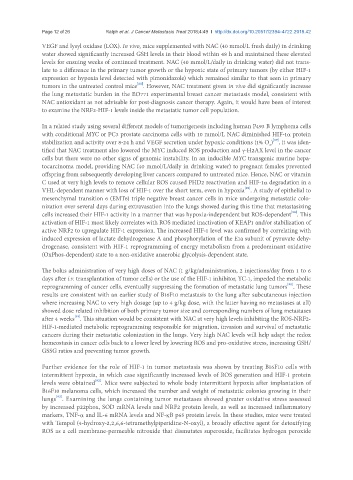Page 592 - Read Online
P. 592
Page 12 of 26 Ralph et al. J Cancer Metastasis Treat 2018;4:49 I http://dx.doi.org/10.20517/2394-4722.2018.42
VEGF and lysyl oxidase (LOX). In vivo, mice supplemented with NAC (40 mmol/L fresh daily) in drinking
water showed significantly increased GSH levels in their blood within 48 h and maintained these elevated
levels for ensuing weeks of continued treatment. NAC (40 mmol/L/daily in drinking water) did not trans-
late to a difference in the primary tumor growth or the hypoxic state of primary tumors (by either HIF-1
expression or hypoxia level detected with pimonidazole) which remained similar to that seen in primary
[88]
tumors in the untreated control mice . However, NAC treatment given in vivo did significantly increase
the lung metastatic burden in the EO771 experimental breast cancer metastasis model, consistent with
NAC antioxidant as not advisable for post-diagnosis cancer therapy. Again, it would have been of interest
to examine the NRF2-HIF-1 levels inside the metastatic tumor cell population.
In a related study using several different models of tumorigenesis including human P493 B lymphoma cells
with conditional MYC or PC3 prostate carcinoma cells with 10 mmol/L NAC diminished HIF-1α protein
[89]
stabilization and activity over 8-24 h and VEGF secretion under hypoxic conditions (1% O ) , it was iden-
2
tified that NAC treatment also lowered the MYC induced ROS production and γ-H2AX level in the cancer
cells but there were no other signs of genomic instability. In an inducible MYC transgenic murine hepa-
tocarcinoma model, providing NAC (40 mmol/L/daily in drinking water) to pregnant females prevented
offspring from subsequently developing liver cancers compared to untreated mice. Hence, NAC or vitamin
C used at very high levels to remove cellular ROS caused PHD2 reactivation and HIF-1α degradation in a
[89]
VHL-dependent manner with loss of HIF-1 over the short term, even in hypoxia . A study of epithelial to
mesenchymal transition 6 (EMT6) triple negative breast cancer cells in mice undergoing metastatic colo-
nization over several days during extravasation into the lungs showed during this time that metastasizing
[90]
cells increased their HIF-1 activity in a manner that was hypoxia-independent but ROS-dependent . This
activation of HIF-1 most likely correlates with ROS mediated inactivation of KEAP1 and/or stabilization of
active NRF2 to upregulate HIF-1 expression. The increased HIF-1 level was confirmed by correlating with
induced expression of lactate dehydrogenase A and phosphorylation of the E1a subunit of pyruvate dehy-
drogenase, consistent with HIF-1 reprogramming of energy metabolism from a predominant oxidative
(OxPhos-dependent) state to a non-oxidative anaerobic glycolysis-dependent state.
The bolus administration of very high doses of NAC (1 g/kg/administration, 2 injections/day from 1 to 6
days after i.v. transplantation of tumor cells) or the use of the HIF-1 inhibitor, YC-1, impeded the metabolic
[90]
reprogramming of cancer cells, eventually suppressing the formation of metastatic lung tumors . These
results are consistent with an earlier study of B16F10 metastasis to the lung after subcutaneous injection
where increasing NAC to very high dosage (up to 4 g/kg dose, with the latter having no metastases at all)
showed dose related inhibition of both primary tumor size and corresponding numbers of lung metastases
[91]
after 4 weeks . This situation would be consistent with NAC at very high levels inhibiting the ROS-NRF2-
HIF-1-mediated metabolic reprogramming responsible for migration, invasion and survival of metastatic
cancers during their metastatic colonization in the lungs. Very high NAC levels will help adapt the redox
homeostasis in cancer cells back to a lower level by lowering ROS and pro-oxidative stress, increasing GSH/
GSSG ratios and preventing tumor growth.
Further evidence for the role of HIF-1 in tumor metastasis was shown by treating B16F10 cells with
intermittent hypoxia, in which case significantly increased levels of ROS generation and HIF-1 protein
[92]
levels were obtained . Mice were subjected to whole body intermittent hypoxia after implantation of
B16F10 melanoma cells, which increased the number and weight of metastatic colonies growing in their
[92]
lungs . Examining the lungs containing tumor metastases showed greater oxidative stress assessed
by increased p22phox, SOD mRNA levels and NRF2 protein levels, as well as increased inflammatory
markers, TNF-α and IL-6 mRNA levels and NF-κB p65 protein levels. In these studies, mice were treated
with Tempol (4-hydroxy-2,2,6,6-tetramethylpiperidine-N-oxyl), a broadly effective agent for detoxifying
ROS as a cell membrane-permeable nitroxide that dismutates superoxide, facilitates hydrogen peroxide

